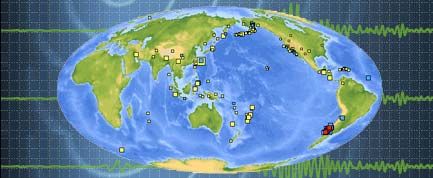Massive Earthquakes Barely Disturb Earth's Natural Rhythms

Yesterday's magnitude-7.2 earthquake that rocked northern Mexico and parts of Southern California was barely worth noting compared to the ongoing, major forces that shape planet Earth. In a geologic sense, there are greater forces at work, from the coming and going of ice ages to an ongoing imbalance in the planet's rotation that make it wobble like a spinning top that's winding down.
Even the monstrous 8.8-magnitude earthquake that struck Chile in February, and which might have changed Earth's rotation and shortened days by a fraction, hardly had an impact on the planet in the long run. In fact, scientists have a hard time spotting the effect of even bigger quakes on something such as the Earth's rotation, said Richard Gross, a geophysicist at NASA's Jet Propulsion Laboratory in Pasadena, Calif.
"These large earthquakes are rare, catastrophic events," Gross explained. "What's normally causing the Earth's rotation to change is the surface mass movement of the oceans and atmosphere."
Those larger normal effects drown out the impact of earthquakes on the Earth's rotation, Gross told LiveScience. And that's not even considering all the other ways that the misshapen Earth wobbles and flexes over the grand geological timescale.
How to change Earth's spin
The Earth typically spins about its north-south axis once every day at 1,000 mph (1,604 kilometers per hour). But the planet's mass is balanced around an axis that differs from the north-south axis by about 33 feet (10 meters).
Huge quakes can change the Earth's rotation by moving mass vertically, not unlike a figure skater pulling her arms inward during a spin to turn faster on the ice. Both the Chilean earthquake in February and the magnitude 9.1 Sumatran earthquake in 2004 – which caused the deadliest tsunami in modern history – had such an effect.
Sign up for the Live Science daily newsletter now
Get the world’s most fascinating discoveries delivered straight to your inbox.
Gross calculated that the Chilean quake shifted the Earth's figure axis by 3 inches (8 cm or 27 milliarcseconds), and shortened the length of an Earth day by 1.26 microseconds.
Few other catastrophic events besides quakes could even make the slightest impact on the Earth's rotation.
"People have looked at volcanoes, but they're just too localized," Gross said. "There's not enough mass-motion involved with a volcanic eruption."
The length of a day normally changes anyway by about one millisecond (1,000 microseconds) each year, because of the seasonal shifts in ocean currents and the atmospheric jet stream.
For instance, the jet stream's southward shift in the northern hemisphere slows down the Earth's rotation slightly during the winter months. The rotation then picks up again during the summer as the jet stream shifts back north.
Not a matter of tilt
Rearranging Earth's mass with earthquakes still does not have any impact on the north-south axis, which the planet spins around.
"This hasn't done anything to the orientation of the [north-south] axis in space," Gross pointed out. "The only way you can change orientation is by external force, such as a major asteroid impact."
But even if the planet's tilt remains at about 23.5 degrees on average, Earth's north-south axis moves around in a cone-shaped pattern like a toy top. The giant wobble pattern, known as precession, makes a complete circle about every 26,000 years. That means Earth's axis won't always point at the current North Star, Polaris.
The planetary tilt itself also undergoes a slight cyclical change over the course of 40,000 years, and is currently decreasing from the maximum 24 degrees to 22.5 degrees. Some studies have tied that cycle to the major ice ages that come and go every 80,000 or 120,000 years.
Squeeze and squash
Glaciers that build up and retreat during ice age cycles can also affect Earth's shape. Earth has always resembled something of a pumpkin with a bulge around the equator, because of how the planet's rotation affects its mass.
Melting ice at the poles takes weight off those areas and allows the Earth to fill out more like a sphere, but ocean currents and the jet stream can redistribute mass either toward or away from the equator.
Don't discount the moon's gravitational tug on the Earth, either. That twice-daily tidal effect causes Earth's crust to flex by about 8 inches (20 cm) each day, and leads to much higher ocean tides.
These flexing movements fortunately don't affect scientists' ability to study the impact of earthquakes on the Earth's rotation. They're more concerned about picking out the tiny quake signal from the bigger background movements of the oceans and the atmosphere.
Watching the quake effect
The effect of the Chilean earthquake and other events still remains a calculation rather than a direct scientific observation. That's partly because scientists don't have all the ocean and atmospheric data available at their fingertips every day, and so they can't compare such background noise with an earthquake's possible impact as it happens.
Current scientific instruments and sensors also just have a hard time detecting earthquake effects on Earth's rotation, even without the normal background noise. More sensitive monitoring systems might someday allow scientists to watch a quake change the Earth's rotation in real-time — but Gross won't hold his breath.
"It's still such a small calculated signal that I'm afraid I have my doubts as to whether I can see it," Gross said.
- 101 Amazing Earth Facts
- Natural Disasters: Top U.S. Threats
- Images: Deadly Earthquakes Past and Present











